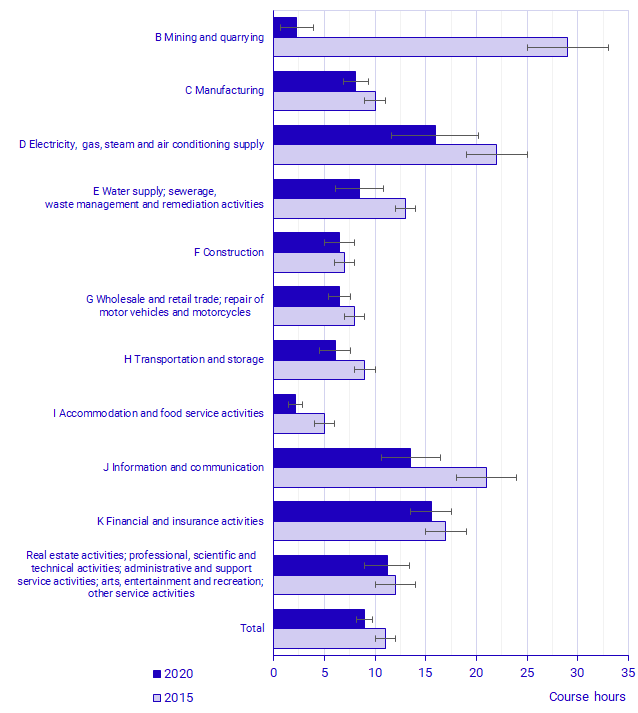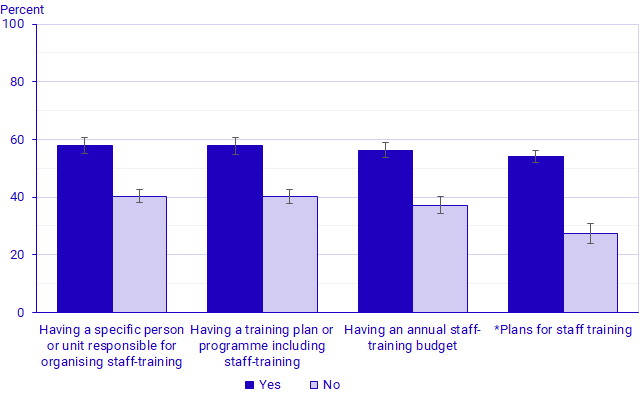Continuing Vocational Training Statistics 2020
Staff training decreased 2020
Statistical news from Statistics Sweden 2023-12-19 8.00
Approximately one half of employees in the enterprises surveyed attended a staff training course in 2020, and, on average, course participants spent 18 hours attending such courses. This yields an average of 9 hours spent by employees attending courses in 2020, which is somewhat less than in 2015, when the average number of course hours per employee was 11.
These results are based on the 2020 Continuing Vocational Training Statistics Survey.
Lower average course hours in 2020 in several economic activities
The total number of course hours per employee fell from 11 (2015) to 9 in 2020, i.e., two fewer hours per employee on average. In all economic activities, the average number of course hours which staff dedicate to training courses fell to some extent or remained unchanged since 2015. The spread of COVID-19 began in Sweden in Q1 2020, impacting the labour market to a great extent and thus even participation in staff training. Employment declined most in those industries which were particularly impacted by travel and social-distancing restrictions adopted pursuant to the pandemic, such as hotels and restaurants. Course participation in the hotel/restaurant industry was already at a low rate as of 2015 (35 percent), and it fell further, to 19 percent, during the pandemic year of 2020. This figure was lowest in a comparison with other industries and is reflected in the low number of course-hours per employee in the industry.
In the economic activity ‘Mining and quarrying,’ the number of course-hours per employee fell from 29 (2015) to 2 hours in 2020. Statistics from the Swedish Agency for Economic and Regional Growth, the Swedish Public Employment Service and Statistics Sweden’s Labour Force Surveys show that the short-time working measures and lay-offs occurring during the Coronavirus pandemic had a limited impact on the economic activity ‘Mining and quarrying’. Nor do workforce levels, which were unchanged in 2020, explain the decline in course-hours. Eighty-four percent of enterprises engaged in ‘Mining and quarrying’ stated that the Coronavirus pandemic limited staff-training offerings. Thirty-eight percent also stated that offerings were limited by lack of time and high workloads. Lack of time may be attributable to the Coronavirus pandemic, as production likely must be maintained to meet demand despite high rates of sickness absence during the pandemic year of 2020.

Total course costs include staff costs for the course-hours which employees use for participation in staff training courses. For this reason, the number of course-hours impacts total course costs. This makes visible the difference between economic activities in terms of course hours when course costs are to be studied. Course costs as a share of total labour costs among the enterprises fell from 1.6 percent (2015) to 1.3 percent in 2020. The average course cost per employee in 2020 was approximately SEK 8,500, and the average course cost per course participant was approximately SEK 16,800.
Strategic staff training work by enterprises increases course participation
Regular staff-training planning has a positive impact on course participation among employees. Enterprises that plan for staff training have demonstrably higher course-participation rates among employees than enterprises that do not. Among enterprises having a specific person or unit responsible for organising staff training, an annual staff-training budget or a staff-training plan, course participation among employees stood at 54 percent. The comparable figure among enterprises which lack regular planning for staff training was 27 percent.
Course participation was greater among larger enterprises, which can be attributed in part to the fact that 9 of 10 large and medium-size enterprises plan for staff training, compared with 7 of 10 small enterprises.

*Plans for staff training means that the enterprise has a person or unit responsible for organising staff training, a staff-training plan or an annual staff-training budget.
Definitions and explanations
The 2020 Continuing Vocational Training Statistics Survey includes, among others, the following results:
- More than 9 of 10 enterprises offered some form of staff training in 2020.
- Greater course participation in large enterprises (55 percent), compared to 43 percent of employees in small enterprises.
- Fewer than half of the enterprises surveyed evaluate future skills needs on a regular basis.
- Employees in Norway participate in courses an average of three additional hours compared with employees in Sweden.
Publication
A more detailed presentation of the survey is published in the theme report Continuing Vocational Training Statistics 2020
Next publishing will be
2027
Feel free to use the facts from this statistical news but remember to state Source: Statistics Sweden.
